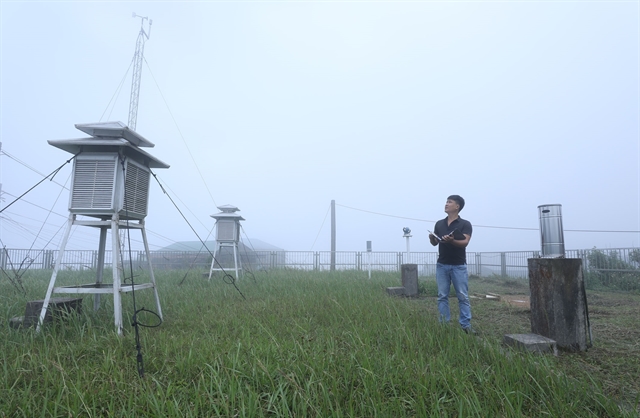 Environment
Environment

 |
| Dr Trần Hồng Thái, Director General of the Department of Meteorology and Hydrology under the Ministry of Natural Resources and Environment. — VNA/VNS Photo Công Tường |
The hydro-meteorology sector is actively deploying Unmanned Aerial Vehicles (UAVs) to monitor dangerous weather conditions, utilise satellite data, ultrasonic technology, radar, laser technology and other advanced tools. Dr Trần Hồng Thái, Director General of the Department of Meteorology and Hydrology under the Ministry of Natural Resources and Environment spoke with the Vietnam News Agency about taking advantages of technology to reduce the risks of natural disasters.
Could you assess the achievements of the hydro-meteorological sector amid increasingly complex and unpredictable natural disasters?
The Department of Meteorology and Hydrology has focused on perfecting policy frameworks and enhancing the State management capacity in the field of meteorology and hydrology. This includes improving fundamental investigation procedures, community-serving forecasting, data storage, climate change monitoring, and international cooperation. Simultaneously, it has bolstered the inspection and timely adjustment of meteorological and hydrological activities in accordance with legal regulations.
The department is currently proposing to the Prime Minister for consideration the project on modernisation of the meteorology and hydrology sector by 2025 and the 2026-2030 period. It is finalising the network planning for the national meteorological and hydrological station system for the period of 2021-2030, with a vision until 2050, to present to the Ministry of Natural Resources and Environment and the Prime Minister for approval.
The department has recommended Decision No18/2021/QD-TTg, which was issued on April 22, 2021, defining the forecasting, warning, and disaster information dissemination and risk level assessment. This decision is aligned with the current practical requirements of forecasting, warning, and disaster information dissemination.
In the area of weather and disaster forecasting, the department has intensified the issuance of specialised forecasting and warning reports to support directive and managerial activities, event organisation and social life. It has also modernised weather forecasting with a contemporary approach aligned with advanced countries worldwide.
The department has successfully updated its information system. Research on the application of advanced specialised equipment is underway to ensure the stable operation of meteorological and hydrological information systems.
Research projects at all levels are witnessing a surge in new studies related to artificial intelligence (AI) to serve the modernisation efforts of the department and contribute effectively to its mission, both within the department and for society as a whole.
In addition, international cooperation continues to expand, significantly contributing to enhancing technical capabilities, financial resources, information exchange, personnel training and the protection of national sovereignty.
The development strategy of the meteorology and hydrology sector was issued and approved by the Prime Minister on November 23, 2021. How has this strategy been implemented?
The Department of Meteorology and Hydrology has intensified efforts in educating and raising awareness and responsibilities of various sectors and the public regarding meteorological and hydrological work. This includes the promotion of Directive No.10-CT/TW issued by the Party Central Committee.
We have streamlined the extraction, utilisation and integration of meteorological and hydrological information and data, monitoring climate change, into the socio-economic development strategies of various ministries, sectors, and localities. It has also strengthened inspections and audits of policy and legal compliance in meteorological and hydrological activities.
The department is currently formulating network planning for the national meteorological and hydrological station system for the period 2021-2030, in order to review and amend it to align with the Planning Law. This planning is under finalisation, taking into account input from the Planning Review Council before submission to the Prime Minister for approval.
The department has developed and submitted key projects to authorised levels for review and approval, with the goal of modernising and automating the national meteorological and hydrological observation network, as well as the information acquisition and forecasting technology.
Furthermore, we have continued to promote research and the application of scientific and technological advancements in forecasting and warning against dangerous weather conditions with the aim of enhancing forecasting and warning capabilities and the quality of disaster information. This aims to establish meteorological and hydrological data repositories integrated into the resource and environmental data systems, ensuring timely, reliable, and highly accurate information, especially regarding the risks of dangerous and extraordinary weather conditions.
Legal regulations and guidelines for meteorological and hydrological activities have become more specific. However, the demands for meteorological and hydrological forecasting and warning are increasing. The frequency and severity of dangerous weather conditions are on the rise. Additionally, the need for socio-economic development requires the department to align more closely with practical realities.
We are facing challenges in integrating with resource and environmental monitoring networks or other national networks. Budget allocation for the development and modernisation of the meteorological and hydrological sector remains limited.
 |
| An official monitors the weather at the Mẫu Sơn Meteorological Station in Lạng Sơn Provincial Hydro-Meteorological Centre. — VNA/VNS Photo Anh Tuấn |
Investing in the meteorology and hydrology sector requires taking a proactive approach. What solutions does the department have to ensure the capacity to provide timely meteorological and hydrological information for disaster prevention and response?
First and foremost, the department is focusing on refining its mechanisms, policies, and organisational structure by reviewing, amending, and supplementing certain provisions of the Meteorology and Hydrology Law. It is also developing and adjusting a system of standards, technical standards, and economic-technical norms related to meteorological and hydrological activities. Simultaneously, the department is streamlining its organisational structure to be more professional and aligned with the strategic development goals of the sector.
We are increasing investments in equipment and technology for automated data collection and processing within the surface meteorological network, upper-air meteorology, hydrology, and marine meteorology. We are also expanding the network of automatic rain gauge stations, especially in areas prone to landslides, flash floods, and flooding, such as the northern mountainous regions, central regions, and Central Highlands.
Additionally, the department is employing Unmanned Aerial Vehicles (UAVs) to monitor dangerous weather conditions, utilise satellite data for Earth observation, and implement ultrasonic, radar, laser and digital camera technologies in the field of meteorology and hydrology.
Furthermore, the department is working on enhancing the centralised data integration system, developing and perfecting shared-use mission-specific software systems for data management, sharing, and dissemination of meteorological and hydrological information. We are building an intelligent meteorological forecasting support system, impact forecasting system, and specialised systems for storms, tropical depression forecasting, and numerical weather model systems that homogenise various surface and remote sensing data types.
In particular, we are working to improve the quality of quantitative precipitation forecasting, from very short-term forecasts to forecasts up to two to three days in advance.
In comprehensive risk assessments and detailed regional assessments of meteorological and hydrological disasters, the department will continue to update climate and water resources, establish a real-time monitoring and warning system for landslides and flash floods in mountainous, midland areas, and down to district and commune levels.
We will also carry out integration and synchronisation of hydrological forecasting models in river basins, along with the development of tools for detailed forecasting of flood extent and depth in downstream areas of river basins and reservoirs.
We will continue research to apply modern technology solutions in forecasting and warning for storms, heavy rainfall, thunderstorms, lightning, flash floods, and landslides. Various meteorological and hydrological forecasting and warning products will also be deployed and disseminated diversely through digital technology platforms. — VNS




